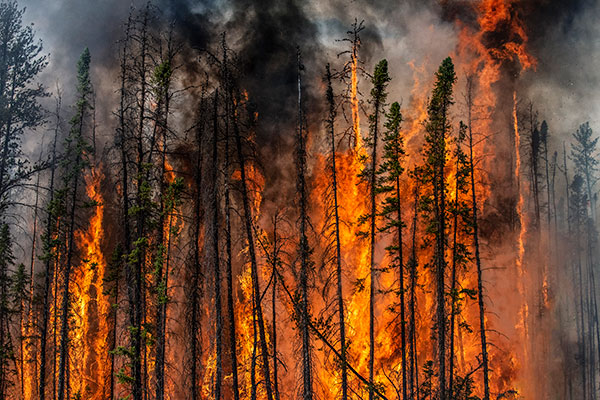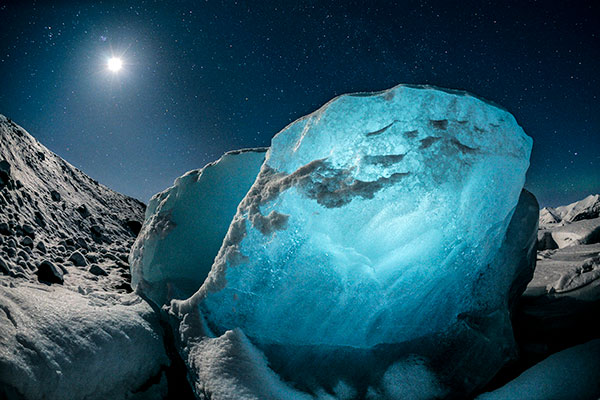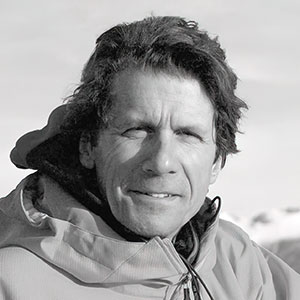James Balog
For 40 years, photographer James Balog has broken new conceptual and artistic ground on one of the most important issues of our era: human modification of nature. During the first phase of his career, he was a photojournalist specializing in projects involving landscape, outdoor adventure, wildlife, and technology. Publications like National Geographic, Time, Life, Fortune, Smithsonian, the New York Times Magazine, and many others in Europe and Asia, presented his work.
An extended study of the plight of wild animals in a changing world—originally published in 1990 as Survivors: A New Vision of Endangered Wildlife—took his work into new dimensions. The series was exhibited at dozens of museums and galleries in the United States and Europe. Three related books followed. Between 1991 and 1995, he probed the intersection of people and technology in a series he named Techno Sapiens. Subsequently, he produced portraits of America’s largest, oldest arboreal citizens in Tree: A New Vision of the American Forest (2004); the work became, in part, a meditation about deforestation.


A 2005 project in Iceland for The New Yorker led to a creative breakthrough about how to reveal climate change through the photography of receding glaciers. In 2007, Balog founded the Extreme Ice Survey (EIS), the most wide-ranging, ground-based, photographic study of glaciers ever conducted. His invention of time-lapse cameras that could withstand the rigours of the polar winter was essential for that effort. EIS became the basis of the film Chasing Ice (which won an Emmy and the Sundance award for cinematography); the 2009 PBS/NOVA special Extreme Ice; three feature stories in National Geographic magazine (2007, 2010, and 2013); and global television, radio, internet, and print media coverage which continues to this day.
EIS became just one of many projects within Earth Vision Institute (EVI), a new entity Balog founded in 2014. EVI’s award-winning 2018 film, The Human Element, was one such creation, capturing the lives of everyday Americans on the front lines of environmental change. In 2021, ideas and imagery embodied in the film expanded into The Human Element: A Time Capsule from the Anthropocene, a 425-page retrospective monograph summarizing James’ lifetime of environmental photography.
In the course of producing his ground-breaking portfolios, James gave birth to concepts, visual treatments, and/or technologies that have influenced and inspired image makers worldwide.
He is Cornell University’s A.D. White Professor-at-Large and a research associate of the Institute of Arctic and Alpine Research at the University of Colorado.
His photographs have been exhibited in hundreds of art museums and galleries, and are in countless public and private collections. He is a recipient of the Ansel Adams Award from the Sierra Club, the Royal Photographic Society’s Hood Medal, the Hamdan International Photography Award (Dubai), the Heinz Award, the American Geophysical Union Presidential Citation, an honorary doctorate, the Aspen Institute Award for Visual Art and Design, the Sam Rose and Julie Walters Prize at Dickinson College, and other accolades.
As an activist, public educator, and global spokesman about climate change, James has given multimedia presentations at an extraordinary range of venues. They include the White House, U.S. Congress, and United Nations headquarters in New York; the landmark United Nations meetings on climate change in Copenhagen (2009) and Paris (2015); Earth Day on the Washington, D.C. mall, the Richmond Forum, the Field Museum, and Vanity Fair’s New Establishment Summit; corporations such as Apple, Qualcomm, and Bloomberg; dozens of universities, including MIT, Cornell, Duke, Stanford, Boston College, Penn State, and the universities of Buffalo, Colorado, Indiana, Iowa, Miami, Missouri, and Washington; the Halki Summit II, sponsored by Patriarch of the Greek Orthodox Church, Bartholomew of Constantinople (Istanbul, 2015); and keynote addresses at the California Academy of Sciences (2013) and Cryosphere 2022 (Reykjavik, Iceland), as well as the “Frontiers in Geophysics” invitational lecture at the American Geophysical Union’s annual meeting (2018, Washington, D.C.).
Born in 1952, James is the father of two daughters. He and his wife Suzanne live at the foot of the Rocky Mountains in Boulder, Colorado. He is an avid outdoor adventurer, having climbed thousands of mountains, technical rock faces, and frozen waterfalls in the Himalayas, Andes, Alaska, Africa, and the U.S; made long ski traverses on deep powder snow in Canada and the Swiss Alps; and floated wilderness rivers in the Arctic and American West.
